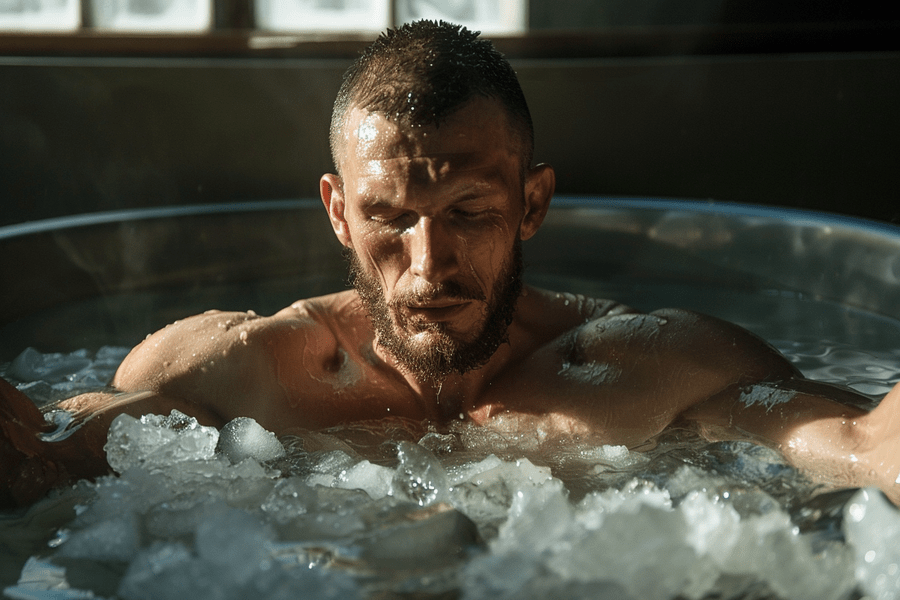
Ice baths have gained popularity among athletes and fitness enthusiasts as a recovery method. This cold therapy involves immersing the body in water between 10-15°C (50-59°F) for short periods, typically 1-5 minutes. Regular ice baths may help reduce inflammation, alleviate muscle soreness, and improve overall recovery after intense physical activity.
The practice of cold water immersion extends beyond sports, with potential benefits for mental health and well-being. Some individuals report improved mood, increased energy levels, and enhanced resilience to stress after incorporating ice baths into their routines. While the scientific evidence is still emerging, anecdotal reports suggest that ice baths may contribute to better sleep quality and heightened alertness throughout the day.
It’s important to note that ice baths are not suitable for everyone. People with certain medical conditions or those unaccustomed to cold exposure should consult a healthcare professional before attempting this therapy. When done properly and safely, ice baths can be a valuable tool for both physical recovery and mental fortitude.
Contents
Science Behind Ice Baths
Ice baths work by triggering specific physiological responses in the body. These responses involve changes in blood flow, temperature regulation, and nervous system activity.
Constriction and Circulation
Ice baths cause vasoconstriction, where blood vessels narrow in response to cold. This process redirects blood flow from the extremities to vital organs.
As the body warms up after the bath, blood vessels dilate again. This alternating constriction and dilation can improve circulation over time.
The cold also stimulates the release of norepinephrine, a hormone that can enhance blood flow and metabolism. This may contribute to the perceived energy boost many people report after ice baths.
Research suggests that cold exposure may increase heart rate variability. This metric is often associated with better cardiovascular health and stress resilience.
Thermoregulation and Cryotherapy
Ice baths rapidly lower skin and muscle temperature. This cooling effect can persist for hours after exiting the bath.
The body responds by activating its thermoregulatory systems to maintain core temperature. This process can increase metabolic rate and calorie burn.
Whole-body cryotherapy, a more extreme form of cold therapy, works on similar principles. It involves brief exposure to very low temperatures, typically using specialised chambers.
Cold exposure activates the sympathetic nervous system. This ‘fight or flight’ response can lead to increased alertness and potentially improved mood.
Some research indicates that regular cold exposure may help modulate the immune system. However, more studies are needed to fully understand these effects.
Physical and Mental Health Benefits

Ice baths offer a range of benefits for both physical and mental well-being. From easing muscle soreness to improving mood, this cold therapy technique can positively impact various aspects of health.
Pain Management and Recovery
Ice baths are known for their ability to reduce muscle soreness and speed up recovery after intense physical activity. The cold water constricts blood vessels, which can help decrease inflammation and swelling in muscles and joints.
When athletes or fitness enthusiasts immerse themselves in cold water, it can numb nerve endings, providing temporary pain relief. This numbness can last for hours after the bath, allowing for more comfortable movement and reduced discomfort.
Research suggests that ice baths may be particularly effective for alleviating delayed onset muscle soreness (DOMS). By reducing inflammation, they can help muscles recover more quickly, potentially allowing for improved performance in subsequent training sessions or competitions.
Mood Improvement and Stress Relief
Cold water immersion can have a significant impact on mental health and emotional wellbeing. The shock of cold water triggers the release of endorphins, the body’s natural feel-good chemicals.
These endorphins can create a sense of euphoria and boost mood. Many people report feeling more alert, energised, and positive after an ice bath. The practice may also help reduce symptoms of depression and anxiety.
The intense physical sensation of cold water can also serve as a form of mindfulness, forcing individuals to focus on the present moment. This can help alleviate stress and promote a sense of calm and clarity.
Enhanced Sleep Quality
Ice baths may contribute to improved sleep patterns and overall sleep quality. The rapid cooling of the body during an ice bath can trigger a natural increase in melatonin production.
Melatonin is a hormone that regulates the sleep-wake cycle. By boosting melatonin levels, ice baths may help individuals fall asleep more easily and experience deeper, more restorative sleep.
The stress-relieving effects of cold water immersion can also contribute to better sleep. By reducing cortisol levels and promoting relaxation, ice baths may help calm the mind and prepare the body for rest.
Regular ice baths, especially when taken in the evening, might help establish a more consistent sleep routine and improve overall sleep hygiene.
Potential Risks and Precautions
Ice baths can pose health risks if not used properly. Certain medical conditions may increase dangers, and improper technique can lead to injury. Awareness of risks and following safety guidelines are crucial for safe ice bath use.
Understanding the Risks
Cold shock response is an immediate risk when entering an ice bath. It can cause rapid breathing and increased heart rate, potentially dangerous for those with heart conditions. Prolonged exposure may lead to hypothermia, where body temperature drops dangerously low.
Frostbite is a risk, especially in extremities. People with Raynaud’s syndrome are particularly susceptible to cold-induced tissue damage. High blood pressure patients should exercise caution, as cold immersion can cause blood pressure spikes.
Open wounds increase infection risk in ice baths. Those with heart disease should consult a doctor before trying ice baths, as the cold stress could trigger cardiac events.
Safe Practices and Consultation
Limit ice bath sessions to 10-15 minutes. Water temperature should be 10-15°C (50-59°F). Begin with shorter durations and gradually increase.
• Always have a spotter present • Exit the bath if you feel numbness or excessive discomfort • Warm up gradually after the bath
Consult a healthcare provider before starting ice bath therapy, especially if you have:
- Heart conditions
- High blood pressure
- Circulatory disorders
- Diabetes
- Pregnancy
Start with once or twice weekly sessions. Monitor your body’s response and adjust accordingly. Proper preparation and adherence to safety guidelines can help minimise risks associated with ice baths.
Comparison with Other Therapies
Ice baths are one of several cold therapy options available for recovery and wellness. They offer unique benefits compared to other modalities, though each approach has its own advantages.
Ice Baths vs. Heat Therapy
Ice baths and heat therapy work in opposite ways to promote recovery. Ice baths constrict blood vessels and reduce inflammation, whilst heat therapy dilates blood vessels and increases blood flow.
Ice baths are typically used immediately after intense exercise or injury to minimise swelling and tissue damage. They can help numb pain and reduce muscle soreness.
Heat therapy, on the other hand, is often applied later in the recovery process. It can help relax tight muscles, improve flexibility, and promote healing by increasing circulation to injured areas.
Both therapies can be effective when used appropriately. Some athletes alternate between cold and heat treatments for optimal results.
Cold Showers and Ice Plunging
Cold showers and ice plunging are alternatives to traditional ice baths that offer similar benefits with some key differences.
Cold showers provide a less intense form of cold therapy. They’re more accessible and can be easily incorporated into daily routines. Whilst not as potent as ice baths, cold showers can still boost mood, improve circulation, and aid recovery.
Ice plunging involves brief immersions in very cold water, often in natural settings. It can be more invigorating than ice baths and may provide additional psychological benefits from the outdoor experience.
Both methods allow for more control over exposure time and temperature compared to ice baths. However, they may not provide the same level of full-body immersion or consistent temperature control.
Frequently Asked Questions
Ice baths offer potential benefits and risks that warrant careful consideration. Proper usage guidelines help maximise positive effects whilst minimising potential downsides.
What are the potential benefits of taking ice baths after a workout?
Ice baths may aid post-workout recovery by reducing inflammation and muscle soreness. The cold water can constrict blood vessels, potentially decreasing swelling and tissue breakdown.
Cold water immersion might also help flush out metabolic waste products from exercised muscles. This could lead to quicker recovery times and improved performance in subsequent training sessions.
Can ice baths assist with weight loss, and if so, how?
Ice baths might contribute to weight loss efforts through increased calorie burn. Exposure to cold temperatures can activate brown fat, which burns calories to generate heat.
The body’s attempt to warm itself after an ice bath may also boost metabolism temporarily. However, ice baths alone are unlikely to lead to significant weight loss without proper diet and exercise.
What are the possible risks or downsides of using ice baths regularly?
Regular ice baths may lead to decreased muscle adaptation if used immediately after strength training. The cold can inhibit inflammation necessary for muscle growth and repair.
Prolonged exposure to cold water carries risks of hypothermia or cold shock. Individuals with certain health conditions, such as cardiovascular issues, should consult a doctor before using ice baths.
How do ice baths affect skin health?
Ice baths may temporarily tighten the skin and reduce inflammation, potentially improving its appearance. The cold can constrict blood vessels, leading to a firmer, more toned look.
However, prolonged exposure to cold water might dry out the skin. Applying moisturiser after an ice bath can help maintain skin hydration and health.
In what ways could ice baths influence mental well-being?
Ice baths may boost mood and reduce stress by triggering the release of endorphins. The shock of cold water can also increase alertness and focus.
Regular cold water exposure might improve resilience to stress and enhance overall mental toughness. Some users report feeling invigorated and refreshed after ice baths.
How long should one typically remain in an ice bath to garner benefits?
The optimal duration for an ice bath typically ranges from 10 to 15 minutes. This timeframe allows for potential benefits without risking hypothermia or excessive discomfort.
Beginners should start with shorter durations, around 5 minutes, and gradually increase as tolerance builds. Water temperature should ideally be between 10-15°C for safety and efficacy.
